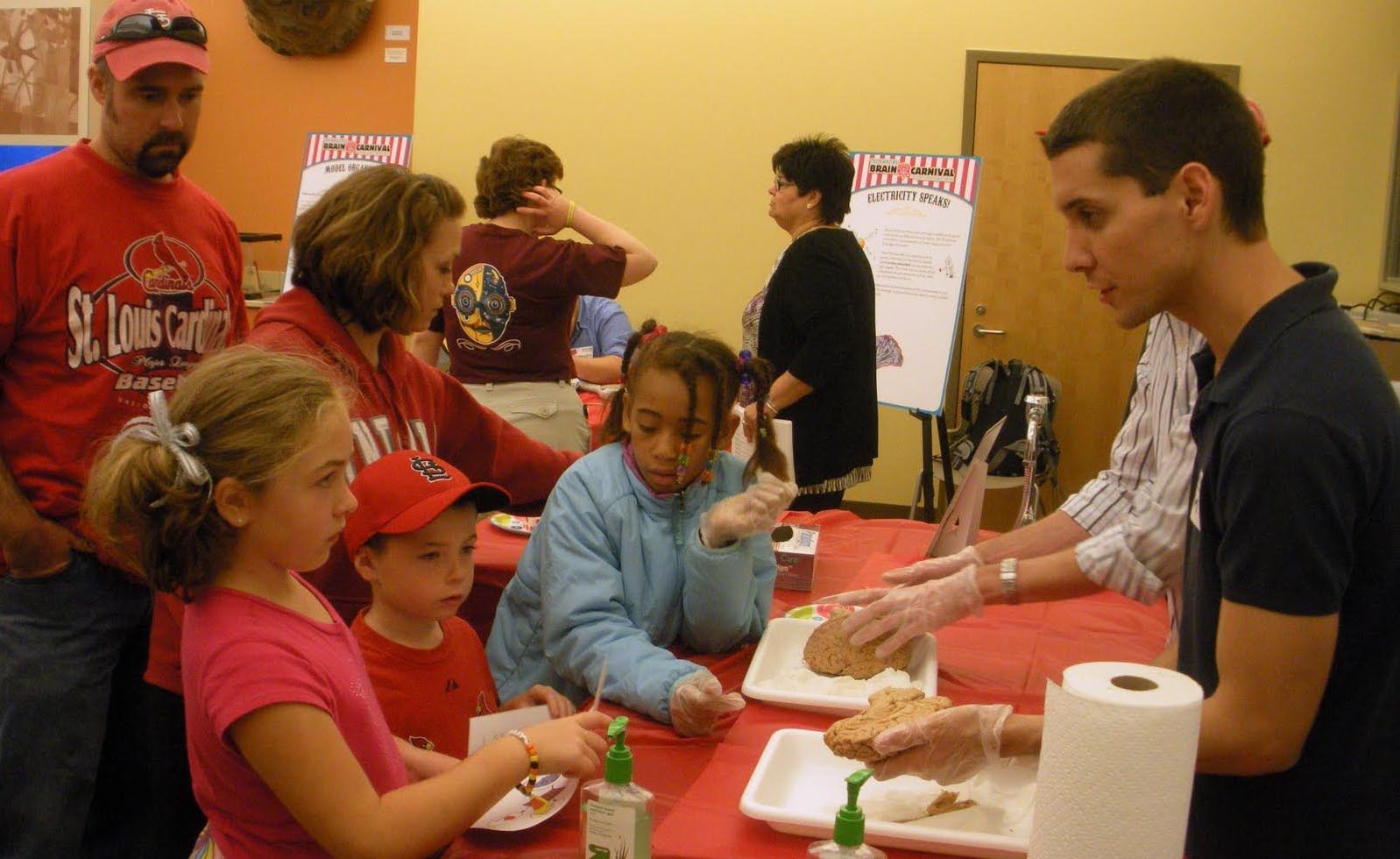


“Part of the purpose of the carnival is to help the students with their communication skills as scientists,” Herzog says. The Science Center provides a workshop on talking to the public. The students go to the center and watch professionals at work, and they practice their exhibits with local teens before they get out in front of the public formally.
“The Science Center has done a really nice job helping us understand how to capture and keep the public’s attention,” he says. “Understanding your audience is the first step. Our students are told to think of the audience as a typical 10-year-old with an attention span of about four minutes.”
The exhibit is actually more sophisticated than that implies, however. When visitors enter the room they are given a brain map and encouraged to get stickers at each landmark on the map, which moves them through brain science all the way from the cellular level to the behavioral level.
The experience can be transformative for the graduate students. Some of them actually have modified their theses topics because of the outreach work, Herzog says. They see what interests people or they discover questions that seem more compelling in talking about their exhibits.
“It’s the neatest experience,” says Melanie Bauer, a third-year psychology graduate student who last year took over as the student facilitator for CCSN outreach. “In fact, I’m probably going to be doing my dissertation research on informal science communication, evaluating this program to see how effective it is.”
But the main goal of outreach is to engage kids with science. Herzog gives five motivators he uses to recruit WUSTL students for public outreach. One is that the United States ranks 27th in the world in the number of students receiving bachelor’s degrees in the sciences, engineering and math.
Another is the state of the St. Louis public schools. Ninety percent of the students in those schools, which were unaccredited from 2007 until this fall, have science skills rated basic or below basic on national tests.
It turns out that informal science is the most effective way to get people interested in science, Herzog says. When asked, people often say it was Bill Nye, the Science Guy, or Mythbusters that first piqued their interest.
Jeffrey Gamble, a second-year graduate student in biomedical engineering studying brain plasticity who will be exhibiting at the carnival this year, admits he watched Bill Nye as a kid.
“All the kids who come to our exhibits leave with information about how they can get paid to do summer research at Washington University and elsewhere in St. Louis,” Herzog says. “For example, we give pamphlets about Washington University’s Young Scientist Program to any kid who’s interested, because you never know where that pamphlet is going to go.”
YES teens and the St. Louis Brain Bee
The ABC students also go to the Science Center on Saturdays to meet with a group of teenagers called YES teens, a group of low-income St. Louis kids dedicated to going to college.
Roughly 40 of the 250 YES teens (YES stands for Youth Exploring Science) are in the neuroscience group, and the ABC students help them prepare for a competition called the Brain Bee that is held in February. The St. Louis Brain Bee winner goes on to a national brain bee and the winner of the national bee goes to an international bee.
“We’ve been helping with YES teens for three years,” Herzog says. “Two years ago, our local winner took ninth at the national bee and won the national spelling bee. As she prepares her college applications, she says she wants to study neuroscience. Last year, our local winner did well in the national competition and then matriculated at Princeton. So we feel we’ve been able to give these kids a valuable experience that shapes their lives,” he says.
The ABC students show their brain carnival exhibits to the YES teens and the teens give them feedback about what works and what doesn’t work. That helps the ABC students, Herzog says, but it also empowers the YES teens because they understand what’s going on, and they can give our students useful feedback.
Gamble has yet to take his exhibit out for a spin, but says he has enjoyed working with the YES teens. “A lot of my friends are outside of science, so I know there is a huge gap between what’s actually happening in science and the public’s understanding of what’s happening,” says Gamble, who often finds himself in the role of a one-man ‘Mythbuster.’ I like the opportunity to talk to kids, not just to bridge the gap in understanding, but also to get kids excited about science. I think both of those are great things.”
Incidentally, Bill Nye is currently at work on a documentary series on the neuroscience of childhood development.
CCSN outreach is funded by a National Science Foundation Integrative Graduate Education and Research Traineeship (IGERT) grant.